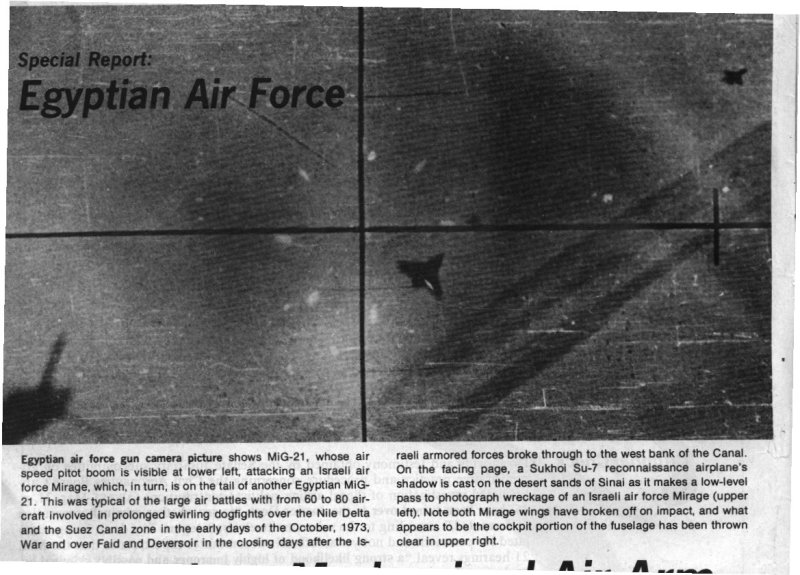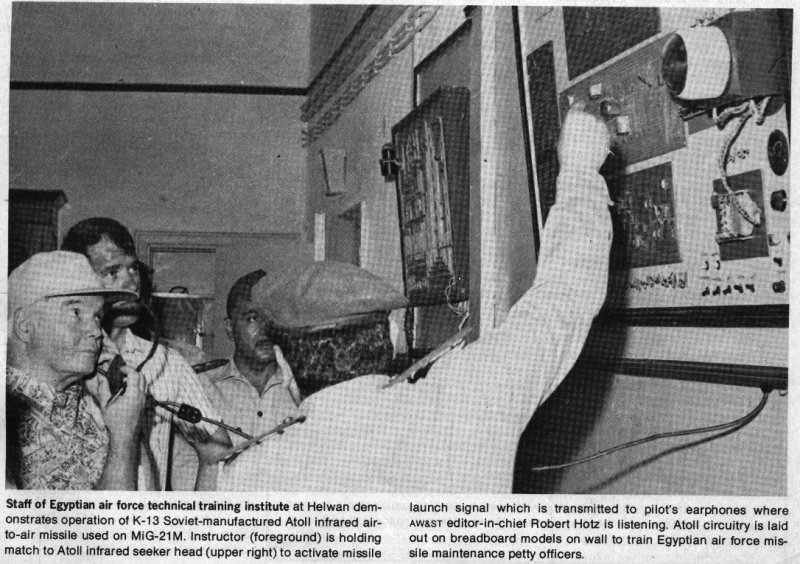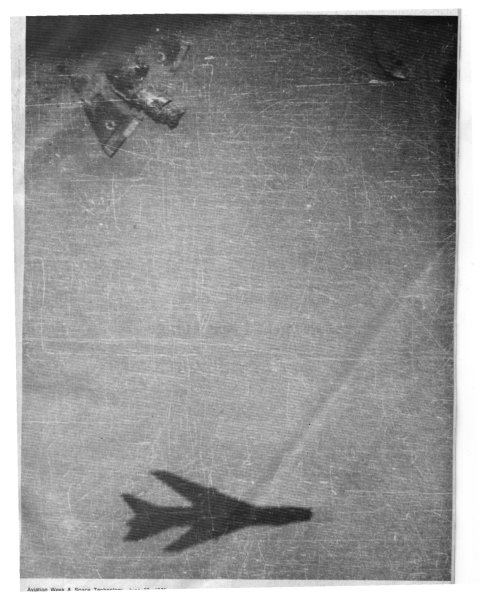Egyptian Air Force
[blockquote] Rebounding from 1967 disaster to strong 1973 showing, nation now seeks multiple sources of new weaponry to match Israelis
By Robert Hotz
Cairo-Egyptian air force bounced back from its humiliating defeat on the ground in 1967 to fight a tough, sustained air battle against the Israeli air force in 1973 and is now transitioning from Russian to Western equipment to expand and modernize its capability.
The Egyptian Ministry of War plans to build a larger and more modern air force with multiple sources of supply to keep pace with any new equipment acquired by the Israeli air force. [/blockquote]
At Mersa Matruh, where the MiG-23 swing-wing attack planes are being assembled, the last of the Soviet-supplied equipment is nearing operational status.
In France, and England, where Egyptian pilots and ground crews are training in Dassault Breguet Mirage fighters and Westland helicopters, the first of the Western-supplied equipment is nearing operational status.
"We are going from the Soviet era of vacuum tubes to the Western technology of integrated circuits," said one high Egyptian air force general, "and we will never again be dependent on a single source of supply."
Current Egyptian air force equipment consists of the MiG-21M day fighter and the MiG-21MF all-weather fighter, the Sukhoi Su-7 and MiG-17 fighter-bombers and a squadron of aging Tupolev Tu-16 Badger bombers equipped with Kelt air-to-ground missiles. The twin-turbine Mil Mi-8 helicopter is the mainstay of its air assault force, with the Mi-6 used for logistics. Main transport fleet consists of Antonov An-12 turboprop cargo planes. During the October, 1973, War, these forces were augmented by two Mirage squadrons from Libya, Su-7 fighter-bomber squadrons from Algeria and Hawker Hunters flown by Iraqi air force pilots. The Mirage squadrons have returned to Libya, but the other foreign contingents remain in Egypt.
Egyptian air force commanders acknowledge the transition period from the aging and combat-worn Russian equip-ment to the newer higher-performance Western equipment is causing some problems in their current state of readiness. They firmly maintain that no Russian aircraft have been received since the end of the October War to replace combat losses, although the Russians have replaced all Syrian combat losses. They say both the MiG-23s delivered last winter and the trickle of spare parts they have received from the Soviet Union are simply delayed fulfillment of pre-war contracts. As a result, the Egyptian air force has had to reduce its standard 20 hr. per month flying schedule to about 15 hr. per pilot and devote a major engineering effort to design and manufacture of spare parts to keep its aircraft combat ready.
There is little doubt after an eight-day visit to radar sites, command posts, SAM batteries, fighter squadrons and technical training institutes and talking to personnel from the air force and air defense commanders down to fighter pilots, engineering officers, SAM battery commanders and radarscope operators that the Egyptian air force regained its morale during the October, 1973, War. In addition, air force commanders feel proud of their combat record, because they were able to play a strong role in the war from the initial assault across the Suez Canal until the cease fire and achieved the following goals:
• Strongly supported the Egyptian army in its initial assault across the Suez Canal and during the establishment of the east bank bridgehead, which the army still holds.
• Blunted the Israeli air force effort to knock out Egyptian airfields in the Nile Delta to the extent that not a single aircraft was destroyed on the ground, no airfield was ever put completely out of operation and no damage was inflicted that was not repairable within a few hours. Egyptian air force commanders say that losses inflicted jointly by their interceptors and air defense force rocket and flak forces became so high that the Israelis abandoned airfield attacks after three days and Israeli air force McDonnell Douglas A-4 Skyhawks were never again used against the air defense system.
• Fought sustained, large-scale air-to-air battles against the Israeli air force over the canal crossings, Port Said and the Deversoir west bank breakthrough, inflicting as well as taking substantial losses but always disputing the battleground air and denying the Israeli air force the high degree of air supremacy to which it had grown accustomed.
The Egyptian air force functioned during these three weeks of combat with a new reconnaissance, command and con-trol system closely integrated with the air defense command forces that enabled it to deploy, reinforce and shift its forces to a degree that the commanders admit would have been impossible a few years ago. They believe the October War combat performance was a result of the following factors that germinated during the 1969-70 war of attrition and were devel- oped in the two years prior to the October, 1973, War:
• Hardening. Major program to harden all airfields, command posts and radar sites with massive concrete shelters for aircraft, fuel dumps, armament stores and repair facilities, many of them covered with thick layers of sand. Highway strips also were developed both for aircraft dispersal and emergency use for quick return to local air battles.
• Training. Shortly after the reorganization of the Egyptian armed forces in 1968, the Egyptian air force increased its training schedule to 20 hr. of flying per month for all operational pilots. As a result of the experience gained during the war of attrition in 1969-70, when the Israeli air force roamed freely over Egypt, the Egyptian air force organized an accelerated training program in tactical operations incorporating all of these enemy-taught lessons. "The Israeli air force showed us all their tricks during 1969-70," a veteran EAF commander noted. "They were our teachers and we applied all those lessons in 1973. It was a very difficult period in 1972-73 when we had to conduct this intensive training and still maintain a high degree of combat readiness."
• Battle damage repair. Special training was given to a wide variety of battle damage repair units, ranging from quick runway repair to on-the-spot repair of battle damage to aircraft, missiles, radars and service vehicles.
• Mobility and deception. Both Egyptian air force and the air defense forces developed an elaborate network of alternate operational sites equipped with dummy radar, aircraft and missiles, and spurious transmissions. They moved their real combat forces around within this pattern to confuse the enemy. The number of Israeli air force attacks on the dummy sites convinced Egyptian commanders their deception was effective.
• Equipment modification. Egyptian air force engineers, using the facilities of the three major aircraft factories at Cairo, Helwan and Heliopolis, made extensive modifications to Russian air and ground equipment to improve combat performance in the specific situations faced in the Middle East. For example, the MiG-21M was modified to carry a larger attack load, get longer range and improve its communications capabilities and firing circuits. The Mi-8 helicopter was modified for an attack role with externally mounted rocket pods and bombs, two fixed heavy machine gun positions and six light machine gun positions to provide heavy covering fire in the landing zone.
Egyptian air force commanders believe they fought two air wars in October. The first lasted from Oct. 6 to 10, during which they believe they, along with their Syrian allies, whittled the Israeli air force (town to about half its original combat strength. Toward the end of this period, they found that Israeli air force activity dwindled to a low level. But after Oct. 16, when they noted the large airlift of U. S. equipment to Tel Aviv and the fly-in of U. S. McDonnell Douglas F-4 Phantoms and A-4 Skyhawks to the Israeli air force base at El Arish in the Sinai, they observed a strong resurgence of enemy air activity.
"We were fighting a new war" an Egyptian air force general told AVIATION WEEK & SPACE TECHNOLOGY. "New planes, new weapons and new tactics. As President Anwar Sadat said, 'we are prepared to fight Israel but not the United States.'"
There is a strong feeling among top Egyptian commanders that American pilots also flew many of the Phantoms they delivered to Israel in combat against the Egyptian and Syrian air forces.
"These Phantom pilots we met after Oct. 17 had a much different style to their combat tactics that we never encountered with the Israelis," one Egyptian air defense commander noted. "Whether they were volunteer reservists or regular U. S. military pilots we don't know, but they certainly were not Israelis."
It is obvious from conversations with officers at various levels in the Egyptian air force that they feel they did not do as well in this second phase as they didvin the first. They also challenge the Israeli claim to have lost only four aircraft in air-to-air combat. The commander of the MiG-21 fighter regiment now based at Inchas noted that his three squadrons had accounted for 22 gun-camera-confirmed air-to-air kills during the war and had the film to prove it.
He said they were mostly Phantoms, because the first objective was to abort Israeli bombing runs, although he had personally downed a Mirage with a K-5 radar-guided missile over Inchas and his regiment downed four Mirages with a loss of one MiG-21 in one of the last battles over Deversoir. In his opinion, many Israeli pilots who punched out of their stricken planes reported they had been bit by a SAM rather than shot down by a MiG to salve their pride.
The fighter pilots at Inchas spoke highly of the MiG-21M day fighter and the MiG-21MF all-weather fighter, which their regiment flew, as a highly maneu-verable, good performing fighter at the low and medium altitudes where most dogfighting occurred. They noted the MiG-21 could turn inside both the Mirage and Phantom, and they tried to close to 23-mm. cannon range for their kills.
This was partly because of their problems with the K-13 Atoll Soviet-made infrared homing missile, which had a very low g-envelop for launch, a relatively small warhead and some problems in coordinating the missile readiness and the target lock-on aural signals in the pilot's headset. There is a solid buzz when the missile is checked out and ready for launch, which shifts to a fluctuating buzz when the Atoll is locked onto a target and can be fired. The lead-computing gyroscopic gunsight on the MiG-21 also tends to tumble at relatively low g-forces, leaving the pilot with only Ms eyeballs and "Kentucky wind age" for his closing range.
The MiG-21M is equipped with an automatic air-ground data link for ground control intercept. Cockpit instruments have two sets of needles, one of which depicts the actual performance of the aircraft and the other the performance required for intercept. Pilots are required to overlay both needles during the intercept maneuver. A small cockpit panel flashes a red warning light if the pilot is not complying with the ground instructions in any category. The GCI data link is designed to bring the MiG-21 to within 20 km. of his airborne target, at which time the pilot takes over with his airborne search radar. When the target is located, he switches to the tracking mode and finishes the attack either with missiles or gun.
In its attack mode, the MiG-21 in the EAF can cany two 500 or four 250-kg. bombs or four rocket pods that fire the 12 rockets in each pod either singly or in ripple fire as determined by the pilot with a cockpit selector.
One veteran MiG-21 pilot, who has been flying for 17 years and saw heavy action in the October War, noted that the excellent flying qualities of the aircraft needed to be supplemented by a better gunsight, another 23-mm. cannon and additional fuel to exploit its potential fully.
The MiG-21 regiment now based at Inchas was equipped with two squadrons of MiG-21 M day fighters armed with K-13 infrared missiles and one squadron of M1G-21MF all-weather fighters armed with a pair of K-5 radar-guided missiles. During the October War, it flew both interceptor and ground attack missions averaging about 100 sorties a day and logging 2,500 sorties for the war. It is commanded by a 40-year-old colonel who was one of the few Egyptian pilots to shoot down a Mirage in the Six-Day War in 1967 and has been in air combat ever since. He has flown all the MiG types beginning with the MiG-15, MiG-17, MiG-19 and five types of MiG-21 and also has flown an F-4 Phantom. He put on a spectacular demonstration of the low-altitude maneuverability of the MiG-21 M during DUT visit.
He noted that his regiment had lost only two pilots during the October War-one making a ground attack in Sinai and the other on the airfield from a delayed action bomb. He said the intensive training of the ground crews enabled alert aircraft to be airborne within 3 min. and aircraft returning from missions were refueled and re-armed in 7 min.
The regiment commander said he and his veteran pilots noted a wide variety in quality and professionalism among the Israeli air force pilots during the opening days of the October War.
"We always hit the Phantoms first to get them to jettison their bomb loads," he said. "But some of the pilots panicked and dropped not only their bombs but also the bomb racks. That is not professional conduct but a sign of panic." And he proudly displays the U. S.-manufactured Phantom bomb racks that a Phantom pilot jettisoned at Inchas.
"They used a standard attack formation of four Phantoms and four Sky-hawks, but after losing over half of these formations to penetrate, they took the Skyhawks off airfield attacks and finally abandoned these targets completely after about three days' battle. Captured Israeli pilots told us their commanders finally decided the losses were too great for the results achieved and gave up attacking airfields.
"We noticed their bombing accuracy decreased as they took heavier losses, and again it appeared that their professionalism was lacking. They also shot down several of then- own aircraft in the dogfights over Port Said, and that too was a mark of panic and inexperience." (This is the first of a two-part series on the Egyptian air force. The second part will be carried in next week's issue.)
Egyptian MiG-21 Kills Mirage Unusual MiG-21 gun camera sequence shows progress of dogfight with Israeli air force Mirage. MiG-21 is on the Mirage’s tail in lower left at start of combat and follows Mirage in steep climbing turn to score hits with 23-mm. cannon. Mirage fuel catches fire as Israeli pilot continues in steep climb. This was one of 22 gun camera - confirmed air victories by a single Egyptian air force fighter regiment.
Примечания В.Михалина
- Статья из “Aviation Week & Space Technology” , vol.102, No.26 от 30.06.1975.
- Добавлю от себя, что на мой взгляд это скорее НЭШЕР, а не МИРАЖ, судя по носу.
- Последняя серия снимков кочевала затем из журнала в журнал…
// Прислал Вячеслав «gals» Михалин
Создано 11.01.2025
Связь с владельцами и администрацией сайта: anonisimov@gmail.com, rwasp1957@yandex.ru и admin@balancer.ru.


